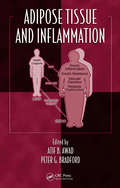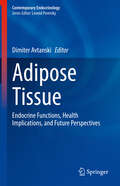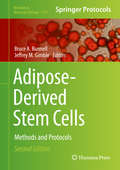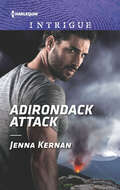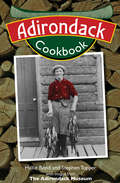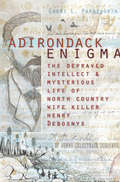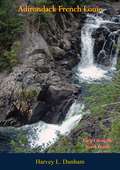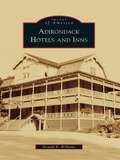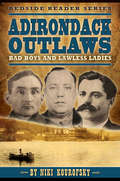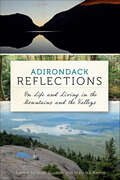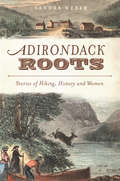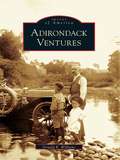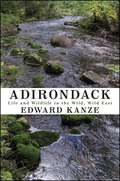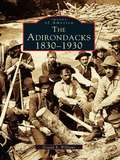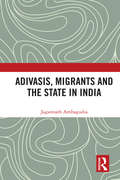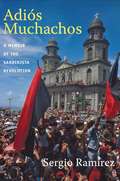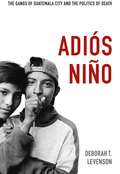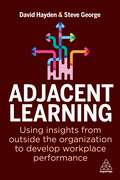- Table View
- List View
Adipose Tissue and Inflammation (Oxidative Stress and Disease)
by Atif B. Awad Peter G. BradfordThe American Obesity Association identifies obesity's link to numerous medical conditions, including hypertension, type 2 diabetes, cardiovascular disease, several cancers, and a host of inflammatory disorders. Evidence indicates that inflammation has more than a corollary relation with obesity; that in fact, obesity itself manifests a low-grade, m
Adipose Tissue: Endocrine Functions, Health Implications, and Future Perspectives (Contemporary Endocrinology)
by Dimiter AvtanskiThis book provides a comprehensive overview of adipose tissue as an endocrine organ and examines its complex biology and clinical significance. It explores the interaction between adipose tissue and various physiological systems and sheds light on how adipose dysfunction contributes to the pathogenesis of metabolic diseases that affect millions of people worldwide. It aims to clarify how the endocrine functions of adipose tissue maintain health and contribute to various metabolic and cardiovascular diseases. With obesity rates escalating globally, understanding the role of adipose tissue and its clinical implications has become critical. Adipose Tissue: Endocrine Functions, Health Implications, and Future Perspectives covers topics ranging from basic science to its clinical significance. It provides a comprehensive view of the clinical manifestations of adipose tissue dysfunction, such as obesity, diabetes, and metabolic syndrome. The book demonstrates the clinical complications associated with adipose tissue dysfunctions and the importance of early detection and intervention. Cutting-edge advancements in adipose tissue research technology and, more importantly, how these findings can translate into clinical practice are discussed, thus offering novel perspectives for future therapeutic strategies. This timely and relevant book targets medical practitioners, clinical researchers, basic scientists, students, and everyone interested in understanding the complex biology of the human body and how a tissue once seen as mere fat storage is now at the forefront of endocrine research and therapy.
Adipose-Derived Stem Cells: Methods And Protocols (Methods In Molecular Biology #702)
by Bruce A. Bunnell Jeffrey M. GimbleDuring the past decade, a wide range of scientific disciplines have adopted the use of adipose-derived stem/stromal cells (ASCs) as an important tool for research and discovery. In Adipose-Derived Stem Cells: Methods and Protocols, experts from the field, including members of the esteemed International Federation of Adipose Therapeutics and Science (IFATS), provide defined and established protocols in order to further codify the utilization of these powerful and accessible cells. With chapters organized around approaches spanning the discovery, pre-clinical, and clinical processes, much of the emphasis is placed on human ASC, while additional techniques involving small and large animal species are included. As a volume in the highly successful Methods in Molecular Biology™ series, the detailed contributions include introductions to their respective topics, lists of the necessary materials and reagents, step-by-step, readily reproducible laboratory protocols, and notes on troubleshooting and avoiding known pitfalls. Comprehensive and cutting-edge, Adipose-Derived Stem Cells: Methods and Protocols serves as a vital reference text for experienced researchers as well as new students on the path to further exploring the incredible potential of ASCs.
Adipose-Derived Stem Cells: Methods and Protocols (Methods in Molecular Biology #2783)
by Bruce A. Bunnell Jeffrey M. Gimble Trivia Frazier Cecilia SanchezSince the publication of the previous editions, there has been increased focus on the use of adipose-derived stromal/stem cells (ASC) and stromal vascular fraction (SVF) cells in three-dimensional hydrogel-based scaffolds for the development of microphysiological systems (MPS) serving as in vitro humanized assays and alternatives to in vivo pre-clinical animal models. This third edition volume discusses of the latest technology and advancements in the field of human-derived ASC and SVF. The chapters in this book are organized into four parts. Part One focuses on human ASC’s isolation, characterization, and differentiation. Part Two describes the isolation and characterization of ASC and SVF from canine, feline, and murine tissues. Part Three looks at hydrogels, scaffolds, and microphysiological systems, and Part Four talks about the new assays and applications using ASC. Written in the highly successful Methods in Molecular Biology series format, chapters include introductions to their respective topics, lists of the necessary materials and reagents, step-by-step, readily reproducible laboratory protocols, and tips on troubleshooting and avoiding known pitfalls.Cutting-edge and comprehensive, Adipose-Derived Stem Cells: Methods and Protocols, Third Edition is a valuable resource for both novice and experts researchers interested in learning more about this important and developing field.
Adipose-Derived Stem Cells: Methods and Protocols (Methods in Molecular Biology #702)
by Bruce A. Bunnell Jeffrey M. GimbleDuring the past decade, a wide range of scientific disciplines have adopted the use of adipose-derived stem/stromal cells (ASCs) as an important tool for research and discovery. In Adipose-Derived Stem Cells: Methods and Protocols, experts from the field, including members of the esteemed International Federation of Adipose Therapeutics and Science (IFATS), provide defined and established protocols in order to further codify the utilization of these powerful and accessible cells. With chapters organized around approaches spanning the discovery, pre-clinical, and clinical processes, much of the emphasis is placed on human ASC, while additional techniques involving small and large animal species are included. As a volume in the highly successful Methods in Molecular BiologyTM series, the detailed contributions include introductions to their respective topics, lists of the necessary materials and reagents, step-by-step, readily reproducible laboratory protocols, and notes on troubleshooting and avoiding known pitfalls. Comprehensive and cutting-edge, Adipose-Derived Stem Cells: Methods and Protocols serves as a vital reference text for experienced researchers as well as new students on the path to further exploring the incredible potential of ASCs.
Adirondack Attack (Protectors at Heart #2)
by Jenna KernanIn this romantic suspense novel, a separated couple gets a second chance when husband and wife are forced to band together against dangerous terrorists.When Detective Dalton Stevens follows his estranged wife, Erin, to the Adirondack Mountains, neither of them expects to be entrusted with intel that must be shared with Homeland Security. Now they’re forced to join together on a harrowing wilderness trek to outrun the terrorists who’ll kill for the secret. Dalton’s real objective—to reconcile with headstrong Erin—happens by chance . . . when one bullet changes everything.
Adirondack Cookbook
by Hallie Bond Stephen TopperThe history, culture and flavor of the Adirondacks is captured in this unique cookbook featuring nearly 100 recipes from the mountains of New York. With the wild woods just outside their doors, the people of the Adirondack Mountains have always enjoyed the freshest of foods that could be hunted, gathered, or harvested. This cookbook offers nearly 100 modern recipes with a rustic twist, making use of the indigenous fish, game, fruits and vegetables of the Adirondacks. Featured recipes include Dandelion Salad, Campfire Trout, Maple-Glazed Root Vegetables, Maple Ice Cream, and Strawberry and Rhubarb Cobbler. Giving historical and cultural context to these and other dishes, authors Hallie Bond and Stephen Topper include fascinating stories and side notes as well as archival photographs from The Adirondack Museum.
Adirondack Enigma: The Depraved Intellect and Mysterious Life of North Country Wife Killer Henry Debosnys
by Cheri L. FarnsworthWhen Henry Debosnys arrived in Essex, New York, the sleepy town was unprepared for the string of dark events that trailed the exotic European stranger. Within weeks of his appearance, he had romanced wealthy widow Betsey Wells, charming her friends and children and presenting the picture of an ideal new family at their spur-of-the-moment wedding. Yet when authorities discovered Betsey's mangled body in a nearby forest, Debosnys's image as a caring family man began to unravel. During his incarceration, Debosnys slowly revealed himself to be a genius fluent in six languages, a master cryptographer and the murderer of at least two previous wives. As the scrutiny on Debosnys intensified, he began producing coded messages, allegedly confessions to a lifetime of villainy. Author Cheri Farnsworth reveals never-before-seen evidence of this Upstate tragedy, including reproductions of the legendary, unsolved Debosnys cryptograms, in an effort to finally uncover the truth about this depraved con man. The only question that remains is who will be the first to crack the "Debosnys Code"?
Adirondack French Louie: Early Life in the North Woods
by Harvey L. DunhamAlthough numerous books have been written about the Adirondacks and Adirondackers, not very many have become regional classics. Early authors such as John Todd, Charles Fenno Hoffman, Jeptha R. Simms, S. H. Hammond, J. T. Headly, Alfred B. Street, William H.H. Murray and Verplanck Colvin earned well-deserved popularity in their day and their literary output still exerts a potent appeal more than a century later. One more volume is eminently entitled to consideration as top-bracket upstate literature...and that is Adirondack French Louie by the late Harvey L. Dunham of Utica.
Adirondack Hotels and Inns
by Donald R. WilliamsThe Adirondack region evolved over years from vast, impassable wilderness to a land of logging camps, tanneries, sawmills, and small settlements. By the end of the 19th century, the area grew again, becoming a tourist destination famed for its great hotels, quaint inns, cottages, and rustic cabins. The hotels and inns spread throughout the Adirondacks, beginning after the Civil War and continuing during the Gilded Age between World Wars I and II. The region drew the rich and famous, as well as workers and families escaping the polluted cities. This volume contains 200 vintage images of those famed accommodations that catered to years of Adirondack visitors. Most of the buildings seen in this book no longer exist, having been destroyed by fires, the wrecking ball, or simply forgotten over time. Adirondack Hotels and Inns provides a timeless look at the vacation retreats of the past.
Adirondack Outlaws: Bad Boys and Lawless Ladies
by Niki KourofskyLocal author and historian Niki Kourofsky exposes the North Country's shadowy past of crime and dark deeds. Her wry, lively storytelling puts readers right in the thick of shootouts, jewel heists, bank robberies, manhunts, and unsolved murders. Spanning eight decades of Adirondack history and ranging from Glens Falls to the Canadian border, Adirondack Outlaws is a rollicking page-turner, rich in chilling details and amply illustrated with historical photographs.
Adirondack Reflections: On Life and Living in the Mountains and the Valleys
by Neal Burdick and Maurice KennyThe Adirondacks have been written about since they were first spied by Europeans more than five hundred years ago. Yet for most of the intervening centuries, few of those writers lived in the region of which they wrote--they were not part of the landscape. That has changed in recent years as writers have moved to the Adirondacks and formed a literary community. Perhaps inspired by these writers, longtime residents have discovered that they, too, could be part of such a community. From scratching out a living in the harsh landscape to the wonders of a moonlit cross-country ski, these writers celebrate life in the Adirondacks. In this remarkable collection of essays, the experiences of Adirondack natives are interwoven with the land in a part of America that is both demanding and rewarding.
Adirondack Roots: Stories of Hiking, History and Women (American Chronicles)
by Sandra WeberThe Adirondack Mountains captivate inhabitants, fostering deep roots and rich memories. In this diverse collection, local author Sandra Weber celebrates this enduring bond with the region and explores its roots and routes--such as women's feats, the naming of mountain peaks and the fight to save forests and tiny alpine plants. From Heart Lake and Caribou Pass to Mount Marcy and Lake Tear, ride an Olympic bobsled run, unearth the destruction of a devastating fire and discover the healing powers of the mountains. Retrace the paths of Theodore Roosevelt, Martha Reben, Edwin Ketchledge, Grace Hudowalski and many others who have lived in and loved the Adirondacks. Unearth hikers' tales, nature's secrets and local legends in this collection of Weber's finest reflections on Adirondack historical adventures.
Adirondack Ventures
by Donald R. WilliamsAdirondack Ventures explores the early man-made features that were introduced into New York State's great mountain and lake region. With some 200 rare photographs, this book recounts the memories of those who took part in the development of the Adirondacks, an area that covers one quarter of the state. To open up these millions of acres, pathways and roadways and, later, small airports and railways were constructed. To enhance the use and enjoyment of the wilderness, bikeways and ski slopes, as well as amusement parks and golf courses, were built.
Adirondack: Life and Wildlife in the Wild, Wild East (Excelsior Editions)
by Edward KanzeWinner of the 2015 Adirondack Literary Award for Best Memoir presented by the Adirondack Center for WritingBorn just north of New York City, Edward Kanze traveled as far as the wilds of Australia and New Zealand, working as a naturalist, park ranger, and nature writer, before finally settling in New York's Adirondacks for the riskiest of all life's adventures: marriage and children. Adirondack tells the story of how he and his wife, Debbie, bought a tumbledown house, rescued it from ruin, started a family, and planted themselves deep in Adirondack soil. Along the way, he brings the unique history of this area to life by sharing stories of his ancestors, who have lived there for generations, and by offering captivating descriptions of the world around him. A keen observer, Kanze will charm readers with his tales of bears, birds, and fluorescent mice.
Adirondacks, The
by Scherelene L. SchatzIn 1892, the Adirondack Park, located in the northeast corner of New York, was declared "forever wild," and from then on, public land could not be further developed. Early on, tourists were drawn to the clear blue lakes, winding rivers and streams, and awe-inspiring mountain peaks of the region. The stunning scenery of the Adirondacks suited the postcard perfectly, making the medium the primary method park visitors used to correspond with family and friends, whether on a trip for healing from tuberculosis and other breathing disorders or vacationing from New York City and the surrounding area. Today the park remains an unspoiled wilderness that continues to draw visitors eager to enjoy its natural beauty.
Adirondacks, The: 1830-1930 (Images of America)
by Donald R. WilliamsThe East's greatest wilderness, the Adirondack region of New York State, shares its history and lore with Native Americans, early settlers, artists, writers, sportsmen, professors, and others. The Adirondacks are known to outdoor lovers, skiers, and year-round visitors for their forty-six high peaks, one-hundred-mile canoe route, one-hundred-thirty-three-mile Northville-to-Lake Placid Trail, thirty thousand miles of mountain streams, and three thousand lakes. The Adirondacks: 1830-1930, tells how the region was first "discovered," explored, and preserved as the six-million-acre Adirondack Park, the largest park in the contiguous United States, a patchwork of public and private lands governed by one of the largest regional zoning plans in the country. With more than two hundred stunning photographs and fascinating tales of the region, it traces the development of the hamlets, the great camps, the guides, and the furniture and tanning businesses.
Adirondacks, The: 1931-1990
by Donald R. WilliamsFor decades, the vast Adirondack wilderness has beckoned. Some, having sampled the treasury of Adirondack art and literature, are drawn by its spectacular beauty; many are lured by its year-round sports and recreational opportunities; others are enticed by its health-giving qualities-the clear air, sparkling waters, and refreshing woodlands. The Adirondacks: 1931-1990 celebrates the years in which the six-million-acre preserve truly became a people's park. With some two hundred rare images, the book includes views of the Winter Olympics held at Lake Placid in 1932, attended by thousands from the world over. It applauds the American boys working in the CCC camps in the Adirondacks during the Great Depression. It follows the steamboats as they ply Lake George and the Fulton Chain and other lakes, as well as the railroads as they bring in more and more visitors. It traces the rise and fall of the grand hotels and their successors: the cabins, motels, cottages, second homes, and campsites of the motoring public. It highlights the music, the architecture, the animals, the crafts-the more recent history of the Adirondack culture.
Adityanum Radhayum Mattu Chilarum (Adityan, Radha, and Others)
by Em Mukundan C. Gopinathan PillaiAdityan doesn't bother to ascertain the beginnings of his trouble-filled life. The financial problems faced by Radha are covered in detail.
Adivasi Rights and Exclusion in India
by V. Srinivasa RaoThis volume examines the processes and impacts of exclusion on the Adivasis (tribal or indigenous people) in India and what repercussions these have for their constitutional rights. The chapters explore a wide range of issues connected to the idea of exclusion — land and forest resources, habitats and livelihoods, health and disease management, gender relations, language and schooling, water resources, poverty, governance, markets and technology, and development challenges — through case studies from different parts of the country. The book argues that any laws intended to safeguard the fundamental rights of Adivasis must acknowledge the fact that their diverse and complex identities are not homogenous, and that uniform laws have failed to address their systemic marginalisation since the colonial era. This work appeals for a serious and meaningful political intervention towards tribal development. The volume will be useful to scholars and researchers of tribal and Third World studies, sociology and social anthropology, exclusion studies and development studies.
Adivasis, Migrants and the State in India
by Jagannath AmbagudiaThis book looks at the contested relationship between Adivasis or the indigenous peoples, migrants and the state in India. It delves into the nature and dynamics of competition and resource conflicts between the Adivasis and the migrants. Drawing on the ground experiences of the Dandakaranya Project – when Bengali migrants from erstwhile East Pakistan (now Bangladesh) were rehabilitated in eastern and central India – the author traces the connection between resource scarcity and the emergence of Naxalite politics in the region in tandem with the key role played by the state. He critically examines the way in which conflicts between these groups emerged and interacted, were shaped and realised through acts and agencies of various kinds, as well as their socio-economic, cultural and political implications. The book explores the contexts and reasons that have led to the dispossession, deprivation and marginalisation of Adivasis. Through rich empirical data, this book presents an in-depth analysis of a contemporary crisis. It will be useful to scholars and researchers of political studies, South Asian politics, conflict studies, political sociology, cultural studies, sociology and social anthropology.
Adiós Muchachos: A Memoir of the Sandinista Revolution
by Sergio Ramírez Stacey Alba SkarAdiós Muchachos is a candid insider's account of the leftist Sandinista revolution in Nicaragua. During the 1970s, Sergio Ramírez led prominent intellectuals, priests, and business leaders to support the Sandinista National Liberation Front (FSLN), against Anastasio Somoza's dictatorship. After the Sandinistas overthrew the Somoza regime in 1979, Ramírez served as vice-president under Daniel Ortega from 1985 until 1990, when the FSLN lost power in a national election. Disillusioned by his former comrades' increasing intolerance of dissent and resistance to democratization, Ramírez defected from the Sandinistas in 1995 and founded the Sandinista Renovation Movement. In Adiós Muchachos, he describes the utopian aspirations for liberation and reform that motivated the Sandinista revolution against the Somoza regime, as well as the triumphs and shortcomings of the movement's leadership as it struggled to turn an insurrection into a government, reconstruct a country beset by poverty and internal conflict, and defend the revolution against the Contras, an armed counterinsurgency supported by the United States. Adiós Muchachos was first published in 1999. Based on a later edition, this translation includes Ramírez's thoughts on more recent developments, including the re-election of Daniel Ortega as president in 2006.
Adiós Niño: The Gangs of Guatemala City and the Politics of Death
by Levenson Deborah T.In Adiós Niño: The Gangs of Guatemala City and the Politics of Death, Deborah T. Levenson examines transformations in the Guatemalan gangs called Maras from their emergence in the 1980s to the early 2000s. A historical study, Adiós Niño describes how fragile spaces of friendship and exploration turned into rigid and violent ones in which youth, and especially young men, came to employ death as a natural way of living for the short period that they expected to survive. Levenson relates the stark changes in the Maras to global, national, and urban deterioration; transregional gangs that intersect with the drug trade; and the Guatemalan military's obliteration of radical popular movements and of social imaginaries of solidarity. Part of Guatemala City's reconfigured social, political, and cultural milieu, with their members often trapped in Guatemala's growing prison system, the gangs are used to justify remilitarization in Guatemala's contemporary postwar, post-peace era. Portraying the Maras as microcosms of broader tragedies, and pointing out the difficulties faced by those youth who seek to escape the gangs, Levenson poses important questions about the relationship between trauma, memory, and historical agency.
Adiós to My Parents
by Héctor Aguilar CamínIt all begins with a faded photograph taken in Chetumal, Mexico in 1938, portraying Emma and Héctor, the parents of Héctor Aguilar Camín, as newlyweds. The author is moved to investigate his family origins, driven by a search for both a familial and personal identity. Adiós to My Parents is a painfully personal story about the need for a narrative that tells you where your grandparents come from, how your parents met, why they married or separated, why they were who they were and why you are who you are. In impeccable, moving prose, Héctor Aguilar Camín delves into his past as far as he can go, reflecting on how fate has lead him back to his parents, whom he hasn't seen for decades, on two different floors of a hospital where they both are ailing.
Adjacent Learning: Using Insights from Outside the Organization to Develop Workplace Performance
by David Hayden Steve GeorgeUse insights from outside the business to rethink workplace learning in order to drive individual and team performance.Workplaces are not the only setting where employees learn. They are learning constantly in all areas of their lives. The problem is that learning and development (L&D) practitioners don't know how to apply the experiences from outside the traditional business setting to improve employee learning and drive business results. Adjacent Learning is a practical guide which solves this problem. Topics covered include acting, difference and emotion through to language, observation and storytelling and explains how these can be used to deliver more effective workplace learning. There is also expert guidance on the importance of employees understanding the 'why' of learning as well as just the 'how' as well as why it's essential to consider experiences from other countries and industries to create diversity of thought which generates the best possible results. Reflection points and key takeaways are included in every chapter as well as interviews with leading figures in the L&D industry. This practical guide is also full of advice, tips and examples throughout to help L&D professionals design a robust learning strategy that will allow employees and the business to thrive.
